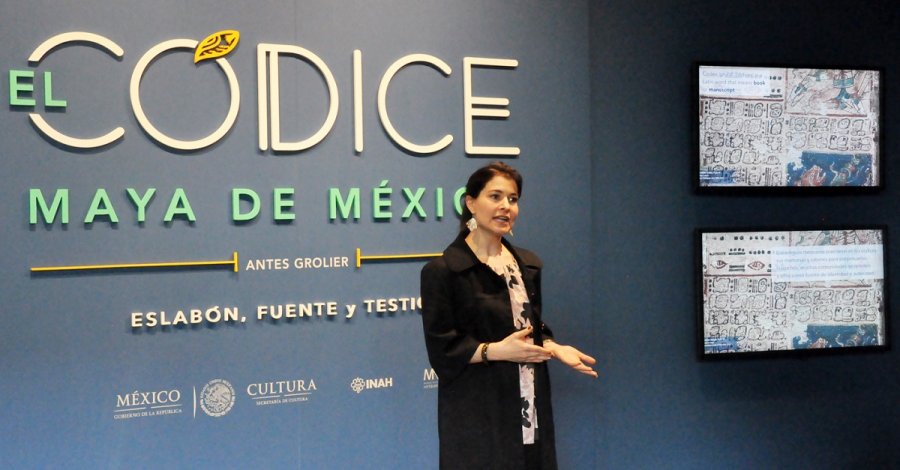Noticias
Until October 28
The Maya Codex of Mexico arrives at the National Museum of Anthropology
September 29, 2018Technology and advances in conservation offer the public the unique opportunity to contemplate directly the oldest legible manuscript in Mesoamerica, exhibited in a showcase 1.75 meters long, which elaborated in amate paper over eight hundred years ago, between 1021 and 1152 A.D., is the Venus calendar and a Maya divinatory document of the early Posclassic period.
The Department of Culture, through the National Institute of Anthropology and History (INAH, for its acronym in Spanish) and the National Museum of Anthropology, presents the exhibition The Maya Codex of Mexico. Link, source and witness, a culmination of the great comprehensive research project, coordinated by Sofía Martínez del Campo Lanz and Baltazar Brito Guadarrama, which cleared up doubts about the legitimacy of the controversial document, and highlights the implications for Mexican culture of the ratification of the only Maya codex in Mexico.
Opened last Thursday as part of the XXIX International Book Fair of Anthropology and History, under the curatorship of the restorer Sofia Martinez del Campo Lanz and the architect Maria del Pilar Cuairán Chavarría, exhibits, in addition to the codex, all the results of the research, through a curatorship and a narrative language inclusive and affordable for all the inhabitants of the site, including thousands of students of basic education.
Martínez del Campo Lanz, who works on the research project for exhibitions of the National Coordination of Museums and Exhibitions of the INAH, highlighted the titanic work involved in the studies of materials and diagnostics of conservation, dating of fibers, anthropophysical analysis of the characters represented, identification of biological attack in the codex and a ritual study of the entire content of the calendar, with a proposal of the days that occurred in the events represented in it, based on the movements of Venus during the early Postclassic.
"The set of results determines that all materials are those used in the pre-Hispanic era; that the complexity and congruence of its ritual content is impossible to have been known by a forger of the twentieth century, and that the facts represented and the austerity of the codex correspond to a time of crisis in Mesoamerica," said the curator, who highlighted the importance of the presence of Mayan blue, "indigo was identified as the colorant with which it is made and Paligorskite clay, which is the mineral that makes indigo become permanent, a result that is decisive to authenticate the antiquity of the codex”.
Considered under historical, cosmogonic and scientific approaches, the exhibition, divided into five sections and articulated around the codex enclosed with argon gas to prevent the proliferation of microorganisms and maintain a stable humidity, has interactive resources with contextual information, through technological tools and Braille language, giving accessibility to all visitors.
As María del Pilar Cuairán explained, "the curatorship that explains what codices are and its importance for Mexico’s culture and identity, has a documentary about the recent history of the document, which had its first public appearance in 1971 at the Grolier Club in New York, and which according to the myth was the object of looting in a dry cave in the Sierra de Chiapas. As well as the controversy that surrounds it, subjecting to close scrutiny the terrible consequences that the looting has for the cultural heritage since very valuable information on the documents in its archaeological context is lost forever".
A temporal context is given so that visitors can learn about the period in which this codex was born and the reason is explained for its stylistic influences from cultures such as the Toltec, as well as its contents and the meaning of each of the deities, symbols and dates expressed in the document, in addition to an iconographic reading and its relationship with other pieces of our heritage.
The tour continues with a series of modules for the interpretation of its cosmovision and contents to end in a tactile sensory space, where each of the pages of the codex is highlighted so that visitors can touch it and feel all the traces of the pages.
The pre-Hispanic manuscript, which is already part of the collection of the National Library of Anthropology and History, will return to its vault to guarantee its conservation and it will be difficult to exhibit it again in near future.
The exhibition is accompanied by a publication that will be presented next October 7, with the academic articles of the research team that left no doubt about the authenticity of the codex.
The Maya Codex of Mexico. Link, source and witness, can be visited until October 28, from Tuesday to Sunday, from 9:00 to 19:00, in the A1 Temporary Exhibitions Room of the National Museum of Anthropology, located on Paseo de la Reforma Avenue and Gandhi S/N, in the Chapultepec Polanco neighborhood of Mexico City.
Mexico
